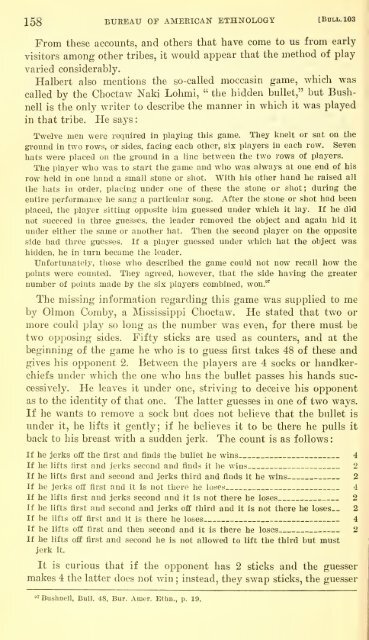siOBX; - Smithsonian Institution
siOBX; - Smithsonian Institution
siOBX; - Smithsonian Institution
You also want an ePaper? Increase the reach of your titles
YUMPU automatically turns print PDFs into web optimized ePapers that Google loves.
158 BUREAU OF AMERICAN ETHNOLOGY [Bull. 103<br />
From these accounts, and others that have come to us from early<br />
visitors among other tribes, it would appear that the method of play<br />
varied considerably.<br />
Halbert also mentions the so-called moccasin game, which was<br />
called by the Choctaw Naki Lohmi, " the hidden bullet," but Bushnell<br />
is the only writer to describe the manner in which it was played<br />
in that tribe. He says<br />
Twelve men were required in playing this game. They knelt or sat on the<br />
gi'ound in two rows, or sides, facing each other, six players in each row. Seven<br />
hats were placed on the ground in a line between the two rows of players.<br />
The player who was to start the game and who was always at one end of his<br />
row held in one hand a small stone or shot. With his other hand he raised all<br />
the hats in order, placing under one of these the stone or shot ; during the<br />
entire performance he sang a particular song. After the stone or shot had been<br />
placed, the player sitting opposite him guessed under which it lay. If he did<br />
not succeed in three guesses, the leader removed the object and again hid it<br />
under either the same or another hat. Then the second player on the opposite<br />
side had three guesses. If a player guessed under which hat the object was<br />
hidden, he in turn became the leader.<br />
Unfortunately, those who described the game could not now recall how the<br />
points were counted. They agreed, however, that the side having the greater<br />
number of points made by the six players combined, won.°^<br />
The missing information regarding this game was supplied to me<br />
by Olmon Comby, a Mississippi Choctaw. He stated that two or<br />
more could play so long as the number was even, for there must be<br />
two opposing sides. Fifty sticks are used as counters, and at the<br />
beginning of the game he who is to guess first takes 48 of these and<br />
gives his opponent 2. Between the players are 4 socks or handker-<br />
chiefs under which the one who has the bullet passes his hands successively.<br />
He leaves it under one, striving to deceive his opponent<br />
as to the identity of that one. The latter guesses in one of two ways.<br />
If he wants to remove a sock but does not believe that the bullet is<br />
under it, he lifts it gently; if he believes it to be there he pulls it<br />
back to his breast with a sudden jerk. The count is as follows<br />
If he jerks off the first and finds the bullet he wins 4<br />
If he lifts first and jerks second and finds it he wins 2<br />
If he lifts first and second and jerks third and finds it he wins 2<br />
If he jerks oif first and it is not there he loses 4<br />
If he lifts first and jerks second and it is not there he loses 2<br />
If he lifts first and second and jerks off third and it is not there he loses 2<br />
If he lifts off first and it is there he loses 4<br />
If he lifts off first and then second and it is there he loses 2<br />
If he lifts off first and second he is not allowed to lift the third but must<br />
jerk it.<br />
It is curious that if the opponent has 2 sticks and the guesser<br />
makes 4 the latter does not win ; instead, they swap sticks, the guesser<br />
^ Bushnell, Bull. 48, Bur. Amer. Ethn., p. 19.

















